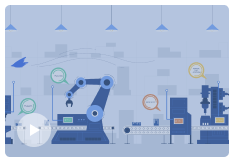The manufacturing process/system of reducing or eliminating the need for human intervention. Automation or “labor-saving technology” uses various control systems to reduce person-hours in exchange for more efficient machine hours.
100+ definitions to help you decode the most important key terms used in manufacturing today.
Download your copyAutomation
Automated Contextualization Technology (ACT)
Automated Contextualization Technology (ACT) is a cognitive computing platform that uses input provided by operators and data from machines, sensors and information systems to compile a real-time, precise and meaningful timeline of events that accounts for 100% of production time and losses. ACT uses artificial intelligence to analyze operator and machine data, learn manufacturing processes and automatically label downtime reasons.
Andon Board
A signaling device that displays the current state of a manufacturing line and notifies management, maintenance teams and other workers of a current or emerging problem. The andon board gives workers the ability to halt production and address production quality issues in a timely manner.
AI-Assisted Manufacturing
AI is used to assist manufacturing plants in a variety of ways including product development. This type of manufacturing occurs when an AI application enables the plant to collect historic and existing data and improve the already existing product using data insights.
Agile Manufacturing
Use of innovative and reliable tools and training in manufacturing to respond to changes in market demands — reducing lead times across plants. Agile manufacturing can include lean and flexible manufacturing, as well as “mass customization” concepts.
Additive Manufacturing
The process by which a computer-rendered model design is produced, layer by layer, by a machine. Also known as 3D printing. This process has made it possible to quickly and efficiently produce prototypes — bringing designs to life in minutes to hours, depending on the intricacy.
Activity-Based Costing
An accounting process that assigns indirect or overhead costs to all products and services based on the consumption by each. This process allows for a more accurate reflection of indirect costs by recognizing certain products or services that require more time than others. The more traditional way of assigning costs simply divides indirect costs evenly across all products and services.
Advanced Manufacturing
Use of the latest generation, smart manufacturing technology to improve work/process systems — allowing for an efficient and improved manufacturing process.
Bottleneck
The point in the production line where congestion occurs due to a backlog. In the occurrence of a bottleneck, production costs generally are increased as the inefficiencies delay production times. A bottleneck occurs most often during the run of a new product or production line, as there may be unknown flaws in the process that need to be identified and corrected.
Bill of Materials (BOM)
The list of all raw materials required to manufacture a product. The bill of materials is generally tied to the production order which reserves the exact quantity of raw materials for the completion of the product. In manufacturing, it refers to the current production configuration or recipe — rather than the actual bill defining the cost of production.
Benchmarking
Use of innovative and reliable tools and training in manufacturing to respond to changes in market demands — reducing lead times across plants. Agile manufacturing can include lean and flexible manufacturing, as well as “mass customization” concepts.
Connected Factory
A factory that uses digital technology, sensors and cloud-based storage to easily share information and help teams make data-driven productivity improvements. A connected factory also aims to empower frontline workers through real-time visibility on their production lines to make continuous improvements and drive operational performance.
Cycle Time
The time required to complete a full cycle of production in manufacturing, from the start of production to the delivery of the final product. This includes processing time, queue time, inspection time and wait time. Also a measure of efficiency through the entire process of manufacturing, by monitoring the cycle time, managers are able to identify bottlenecks and potential solutions.
Cross-Training
The process of training employees in several skills and positions allowing them to work adequately in multiple areas of the organization. It promotes efficiency as no one person is responsible or knowledgeable of a task, meaning when a production error occurs, most or all employees are capable of handling the error without having to pause production. Also beneficial in strategic succession-planning, employees are set to learn new skills to fill roles in plant leadership or management as they become skilled in all areas of production.
Corrective Action Request (CAR)
A request sent to a manufacturer to open an investigation into the defect of a specific product. This procedure is used to initiate corrective action, address the root cause of the defect and prevent future instances of the issue.
Corrective Action Preventative Action (CAPA)
The process of investigating, identifying and addressing issues or problems where corrective action is taken to eliminate the root cause of the issues. This method looks at the manufacturing process, customer complaints and internal audits to identify where undesirable outcomes occur and seeks to prevent them from happening in the future. In manufacturing, CAPA is used to improve operations and the plant’s end products by eliminating all possibilities for error. CAPA may also be required in certain industries where quality assurance is crucial in the final product including: pharmaceuticals and medical device manufacturing.
Continuous-Flow Manufacturing (CFM)
A method of manufacturing where the materials being processed are constantly moving through the production line until the final product is complete. Ideally, products would move sequentially through the system at a pace that reduces delay and lead times. Also known as continuous manufacturing, continuous flow or continuous processing.
Computer-Aided Manufacturing (CAM)
The process of using computer-controlled machinery and software to increase efficiency of production and decrease the need for human intervention. A computer algorithm checks for errors in the original design and configures the machine to maximize efficiency.
Computer-Aided Design (CAD)
The use of computer-based software to assist in the designing and rendering of 2D and 3D models — replacing traditional drafting. CAD enables models to have increased accuracy, improved quality and testing of manufacturing viability. It also produces electronic files for all drafts of a project.
Composites
A composition of two or more materials with significant differences. Commonly found in structural supports of bridges and buildings, electronics and cars, they are chosen for their strength, durability and lower cost.
Compliance Mark
A physical mark placed on the product or packaging stating that a product has met its regulatory standards and specific requirements. These marks indicate that they may be sold in the respective economic areas regardless of the country of origin.
Compliance
The technical, legal and corporate regulations imposed on an organization that must be followed for the production and marketing of products. Regulations can range from environmental standards, health and safety laws, and product safety requirements.
Contract Manufacturer (CM)
A manufacturer hired by an organization to manufacture or assemble all or part of the final product. Organizations save money as the CM will have all of the experience and assets required for production.
Contextual Time
Contextual Time is an accurate, meaningful account of 100% of production time and losses. It is a precise timeline of events compiled in real-time using context provided by operators and data from machines, sensors and information systems.
Child Item
An assembly or subassembly of a final product that appears in the product’s bill of materials. The items are generally said to be the child of the final product.
Change Order
A request or proposal to modify the current manufacturing process or equipment. A change order is usually required for corrective action to be taken.
Change Management
Change management is the process of creating, reviewing and implementing change in manufacturing. Change typically begins when a machinist, supervisor or engineer identifies a problem in production. The formal request for change is then submitted and the process ends when an agreement for change is made among stakeholders. Organizational change often requires many levels of cooperation from various departments and leaders. Developing a structured approach to change ensures a beneficial transition throughout the change process.
Changeover
A process that takes place when a production line or machine is converted from producing one product to another. In manufacturing, changeover is also a measurement of the time it takes to convert machines and production lines. In a lean manufacturing system, changeover times should be brief in order to maximize efficiency and reduce waste.
Cellular Manufacturing
A manufacturing process that produces similar parts or products within a well-defined group, area of machines or production unit within a manufacturing plant. Workers are generally cross-trained to perform a variety of tasks, streamlining the manufacturing process, improving production efficiency and granting operational autonomy.
Digital Twins
A virtual representation of an object or system that spans its lifecycle, is updated from real-time data, and uses simulation, machine learning and reasoning to help with decision-making.
Downtime Tagging
The process of tagging periods of downtime in your production line and categorizing them according to the reason they are down. Examples include: a lack of production materials, no operator and equipment maintenance.
Document Change Request (DCR)
A call for the adjustment of a system or process where a problem has occurred. Change requests generally stem from non-conformities or bugs within the product that are brought to attention by users, development in other systems, a change in standard operations or demands from senior management.
Discrete Manufacturing
The production of physically distinct products that can be identified either by serial number or by physical appearance. Examples include: cars, smartphones or toys. Discrete manufacturing is unable to be continuous as the final product is composed from many different inputs.
Digital Manufacturing
The process of improving product design and manufacturing through the integration of information systems across the supply chain. Digital manufacturing aims to reduce the time and cost of manufacturing by digitizing all processes including design, production and product use.
Device Master Record (DMR)
The collection of records containing the procedures and specifications for manufacturing a finished product used in quality management systems. The DMR includes the bill of materials, product and material specifications, design drafts, packaging and assembly instructions, any post-production cleaning and any hardware or software specifications and source codes.
Device History Record (DHR)
A collection of records that contain the production history of all versions of a product including: serial and lot numbers, number of products produced, and any complaints or issues that are lodged against the product. A DHR may be required to meet regulatory measures in the production of certain products including medical devices.
Design History File (DHF)
The collection of records documenting all stages of the design phase. The DHF shows the product development process through a collection of drafts that detail decision making, meeting notes, test data and reports.
Enterprise Resource Planning (ERP)
A strategy used to track business activities. ERPs are often combined in a suite of applications — allowing all departments to be monitored from a central database and easing information flow to stakeholders. An ERP enables manufacturers to effectively model and analyze data across departments in real-time.
Engineering Change Request (ECR)
A change request proposing improvements or problems with components or assemblies. In change management, the ERC is the first step in enacting corrective action in the manufacturing process. The ECR documents the reason for the change request and lists items in the bill of materials that may be impacted by the proposed change.
Engineering Change Order (ECO)
The documentation outlining the proposed change to the design, lists the product or parts affected and requests review and approval from the manufacturers. The ECO is used to make modifications to material, assemblies and subassemblies and other types of product information. An ECO can be issued when an error is found and corrective action is taken. It is common for an ECO to be issued in technology manufacturing when an electronic component becomes obsolete or reaches the end of its life cycle.
Engineering Change Notice (ECN)
An official notice that communicates the details of an approved change and authorizes a manufacturer to implement the change to the production. The ECN is generally issued when a problem arises and is reported by a customer, manufacturing partner or internal stakeholder.
Electronic Design Automation (EDA)
Software tools used to develop integrated circuit systems and printed circuit boards. Also known as electronic computer-aided design (ECAD).
Form, Fit and Function (FFF)
A framework to describe identifying characteristics of an item. Using this framework allows for changes to be made without documentation — as long as they align with the form, fit and function of the product. Form refers to physical characteristics including shape, size, dimensions, weight and other uniquely distinguishable characteristics. Fit is the ability of a product or subassembly to connect or become an essential part of another product. The function is the effective and reliable action a product or subassembly is designed to perform.
Field Failure Request (FFR)
A type of change request detailing a problem with the product reported by the end-user known as the “field.” By documenting field failure requests, manufacturers can implement changes into the design or manufacturing process to prevent reoccurrence.
Feeder Line
A special assembly line where pre-assembly tasks are performed off the main production line. Pre-assembly off the main production line increases efficiency, improves quality and lessens the lead time of production.
Good Manufacturing Practice (GMP)
A system for ensuring that products are consistently produced and controlled according to quality standards. It is designed to minimize the risks involved in any pharmaceutical production that cannot be eliminated through testing the final product.
Item Master
The record that lists key inventory item information. Used to assign costs and construct the bill of materials it includes: item description, weight, dimensions, quantity on hand and cost of goods.
ISO 14000
The International Standards Organization 14000 is a set of standards and guidelines related to environmental management to help organizations minimize how their operations negatively affect the environment. This standard offers assurance to stakeholders that environmental impact is accurately being measured and improved.
ISO 13485
The International Standards Organization 13485 is a quality-process auditing program specific to the manufacturing of medical devices used to ensure product quality and reliability.
ISO 9000
The International Standards Organization 9000 is a set of quality management principles that manufacturers adhere to, to ensure consumers are consistently getting high-quality products.
Intelligent Manufacturing System (IMS)
The entire smart system that is put in place with manufacturing software. Having an IMS in place puts organizations ahead of competition and allows for the development of solutions to future-proofing production plants.
Intelligent Manufacturing Software
Software installed in the heart of the manufacturing plant and uses the plant network to connect to all of the automated machines. These machines relay data to a central hub where it can be viewed by production staff and operators.
Industry 4.0
Commonly referred to as the Fourth Industrial Revolution or 4th Industrial Revolution (4IR). It is characterized as bridging the gap between physical production and digital manufacturing using automation and data exchange technologies.
Just-In-Time (JIT)
A planning technique used to reduce inventory on hand, setup times and waste. In JIT management, raw materials are ordered to correspond with the production schedule.
Kitting
A process where assemblers are given containers (kit) of all parts needed for production — eliminating the need for constant movement of inventory and tools. The kit is placed at the point of use through the production line where it will be used. Kitting reduces production requirements and increases manufacturing efficiency as items needed for production are stored and shipped together.
Kanban
A Japanese term meaning “billboard or signage”. A lean manufacturing method of managing and improving workflow by visualizing the processes to balance demands with available capacity and avoiding bottlenecks and idle time within the system. Its core purpose is minimizing waste activities without sacrificing productivity, creating more value without generating more costs.
Kaizen
A Japanese business philosophy meaning “change for the better” or “continuous improvement”. In manufacturing, it refers to the gradual and ongoing changes in operations in the present that will consequently have significant, positive impacts in the future. Kaizen empowers workers to make small changes to get stronger results.
Lean Manufacturing
A practice that aims to reduce wasted time, effort and other resources in the production process without sacrificing productivity and efficiency. Lean manufacturing is built on the idea that the reduction of waste can be more profitable than an increase in sales. Waste can appear in several cases including: an overburden or inequality in workloads, material waste, and inefficient production process.
Lead Time
The total time a customer must wait to receive a product after placing an order. Can be broken down into: order preparation, setup, run time, production and inspection. By breaking down lead time, managers can examine points in production where there are inefficiencies. For products that are made-to-order, the lead time is the time between the order and the shipment of the final product that fulfills the order. Whereas for make-to-stock product, lead time is the time between the order and when the product is received into the finished goods inventory.
Monument
A process, machine or technology that is large and unmovable, and requires that everything needed for production be brought to the machine. This can lead to wait times for processing and lacks the ability to manufacture in a continuous flow.
Mean Time To Repair (MTTR)
An operational excellence measurement using the mean (average) measurement by time in minutes. MTTR is calculated as total amount of time required to repair a system and restore it to full functionality divided by the total number of repairs. For example: 200 total hours of maintenance time / 14 total repair instances = 14 minutes of average time maintaining the system.
Mean Time To Failure (MTTF)
An asset lifespan measurement using the mean (average) measured by time, in hours. MTTF is calculated as total time of operation, divided by total number of units produced. For example: 100,000 total hours until failure / 5 machines = 20,000 hours until machine failure.
Mean Time Between Failures (MTBF)
A predictive reliability measurement using the mean (average) measured by time, in hours, between failures of a system. MTBF is calculated as total number of operational hours divided by total number of failures. For example: 10,000 stamping hours / 12 failures = 833 hours between failures.
Markup
A percent over the cost incurred. Markup is the difference between the selling price of a product and the cost to manufacture it. As part of the business model, markup is added to cover the cost of production and generate a profit from the sales of products.
Material Requirements Planning (MRP)
The computer-based process of preparing, scheduling and controlling inventory and raw materials to be purchased and used in the manufacturing process. MRP works backwards from production, utilizing forecasted sales to determine raw materials and components needed to meet anticipated sales. Proper MRP is a crucial aspect in manufacturing as an abundance of unused inventory can negatively affect profitability and a short supply of inventory slows production.
Manufacturing Execution System (MES)
Digital manufacturing systems used to document and trace the conversion of raw materials into finished products, by managing functional aspects of production across the product lifecycle This includes: materials usage, downtime and overall equipment effectiveness. An MES provides data to be used in decision-making for optimizing the production process.
Manufacturing Cycle Time
The total time taken to convert raw materials into finished goods. It starts the moment a customer order is received until the completion of product manufacturing, assembly and testing. This also includes processing, wait and queue times. By detailing the average manufacturing cycle time, managers can analyze and understand reasons for lags or delays within the manufacturing system.
Manufacturing Cost
The cost directly traced to the manufacturing of a product. This includes direct and indirect labor, equipment and maintenance, manufacturing support and overhead. Manufacturing costs also include those that can be directly traced to the manufacturing of the product.
Manufacturing Change Request (MCR)
A change request used to propose a new change to the manufacturing process that does not require a change in the design to the product.
Manufacturing Change Order (MCO)
A change order used to make a manufacturing change to a product. Manufacturing change orders do not require a product design change and are often accompanied by an engineering change order.
Made-To-Spec
A product that is made to the specification of an internal design or by a supplier.
NPD Process
A disciplined set of tasks describing the means by which a company repetitively converts ideas into salable products or services. The process includes: idea generation, prototype testing, market strategy and product launch.
New Product Development (NPD)
The process of conceptualizing, designing, planning and commercializing a new product to be brought to market. More broadly, new product development is the transformation of a market opportunity into a sellable product. NPD requires an understanding of consumer needs, the nature of the market and competition. In order to maintain profitability firms must design products that have a competitive edge in the market.
Overall Equipment Effectiveness (OEE)
The measurement of utilization of raw materials, time and machinery — where 100% indicates firms are manufacturing products as efficiently as possible with no defects and no lag time. By measuring OEE, managers can assess overall production performance and generate insights to improve workflow.
Original Equipment Manufacturer (OEM)
An organization whose parts or equipment is used as components in the products of another manufacturer, which then markets or sells the finished product.
Off-The-Shelf
A product that is sold by the manufacturer as it was originally designed, with no need for engineering or design services.
Push Production
A traditional manufacturing process that uses market estimates rather than customer orders to initiate production. Opposite to pull production, push production is better suited for meeting market demand as there will always be inventory available to be sold.
Pull Production
A lean manufacturing process in which products are made only when the customer has ordered a product, and not before, to prevent unnecessary building and limit extra inventory.
Prototype
A sample model of a product that can be tested and manipulated to identify any potential flaw or errors in the design.
Product Record
All design, manufacturing, quality, sales and information about a product. The product record is critical to effective product life cycle management since multiple product records may exist if supplied by multiple parties.
Product Lifecycle Management (PLM)
The management of product records including: bills of materials, specifications, CAD files, revisions and changes, from the initial design and prototype to the end-of-life delivery and service. Product lifecycle management integrates people, business systems and processes into the core of a product.
Product Development Cycle
The period from when product design begins to the time that the final product becomes available for purchase, often called, time-to-market. When introducing a new product to a market, the product-development cycle is crucial to monitor as being late to introduce products results in lost revenue and sales.
Process Manufacturing
The assembly of products using a formula or recipe, also referred to as “batches”, where they are unable to be disassembled into their original raw material. Examples include: oil, food and beverage products and pharmaceuticals. Process manufacturing is the opposite of discrete manufacturing and is better suited to continuous-flow manufacturing.
Product Data Management (PDM) System
A database system used in product lifecycle management to hold all CAD files, parts and assembly, models and product drawing. Can be referred to as a “work in progress vault” or file repository used by stakeholders to share a common understanding of the product life cycle and manufacturing processes.
Process Control
The digital monitoring of the entire production process through software to maintain production efficiency, safety and consistency.
Poka-Yoke
A Japanese term meaning “mistake-proofing” or “error-proofing”. Poka-yoke is a method used to eliminate errors by effectively making it impossible to make mistakes in a given process. In manufacturing, poka-yoke devices spot potential errors as or before they occur throughout the production cycle.
Point Of Use (POU)
A technique of distributing products and tools to the point that they will be used in the manufacturing process. With POU methods, manufacturing plants can reduce lead time, manufacturing cycle time, and improve efficiency and potential profitability.
Parent Item
A product that contains a secondary product or subassembly (child item) in its bill of materials. The relationship between product and subassembly is described as a parent-child relationship.
Quality Management System (QMS)
A system used to document the aspects of a company’s design and operations including: monitoring, issue reporting and continuous improvements to ensure that product design and manufacturing are repeatable. A QMS also helps to ensure that production is meeting consumer and regulatory requirements.
Return Material Authorization (RMA)
A financial and work order tracking key used to identify a returned item’s origin. The RMA is the process where a customer returns an unneeded or damaged product to the supplier or manufacturer in exchange for a refund, replacement or credit to the consumer’s account.
Robotics
The intersection of mechanical or electrical engineering and computer science used to design, construct, operate and use robots. Robotics includes programmable computer systems for control, sensory feedback, and information processing, integrated with multifunctional machines designed to move materials or parts, or specialized devices through various motions for the performance of a task.
Right-Sizing
The process that challenges the complexity of the equipment by examining how it fits into an overall vision of factory workflow.
Restriction of Hazardous Substances (RoHS)
A mandate issued by the European Union that restricts the usage of six hazardous substances –– lead, mercury, cadmium, hexavalent chromium, polybrominated biphenyls and polybrominated diphenyl ethers –– in products sold within the EU. The restricted materials have been banned due to polluting landfills and contributing to occupational hazards in manufacturing and recycling.
Revision Control
The process of tracking and documenting changes to: a product, part, process, program, design or document.
Revision
A snapshot of a product, part, process, program, design or document at any moment in its development often found in the bill of materials. It allows engineers to see all components that go into the manufacturing of a product of a specific version.
Redline
The marking of an assembly drawing or bill of materials to indicate a modification or change in the process and manufacturing of a product.
Rapid Prototyping
A technique used to quickly produce a model of a part or assembly using 3D printing or additive manufacturing. By using rapid prototyping technologies, engineers and designers are able to complete the final design for production without drastically affecting the time-to-market.
Single-Minute Exchange of Die (SMED)
A system for dramatically reducing the time it takes to complete equipment changeovers. The essence of SMED is to convert as many changeover steps as possible to be performed while the equipment is running, and to simplify and streamline the remaining steps.
Supplier Corrective Action Request (SCAR)
A change request that describes an issue with a part, process, or component of a product from a manufacturer. In engineering quality management, the actions taken to fix the root problem described in the SCAR are documented to ensure the issue doesn’t happen again.
Stock Keeping Unit (SKU)
A unique code, often represented as a barcode, that identifies a component or product and all of the attributes associated with it. Examples include: manufacturer, description, material, size and colour.
Standard Operating Procedure (SOP)
A written document or instruction detailing the steps and activities included in a process or procedure. Standards of operation increase efficiency through the detailed instructions of a process. By following these standards, managers can ensure manufacturing regulations are met while increasing performance and quality assurance.
Smart Manufacturing
A combination of connected/IoT devices, sensors and robotics used to control the entire design and manufacturing process in a plant. Aimed at reducing costs, smart manufacturing makes use of real-time data processing, innovative process modeling and simulations, and control to successfully manage energy and material use throughout the manufacturing process.
Six Sigma
A data-driven quality measure and continuous improvement methodology used to increase quality control by addressing issues within manufacturing processes — in order to reduce defects. Six Sigma methods can produce a more efficient, robust manufacturing process that guarantees production is defect-free 99.999966% of the time.
Single-Minute Exchange of Dies (SMED)
A lean manufacturing method that provides efficient and quick ways of converting from one product to the next. Ideally taking less than 10 minutes or a single-digit minute, this process of changeover is key to reducing manufacturing cycle time, uneven production flow and increasing efficiency along the system.
Total Effective Equipment Performance (TEEP)
A performance metric that provides insights as to the true capacity of your manufacturing operation. It takes into account both equipment losses (as measured by OEE) and schedule losses (as measured by utilization).
Takt Time
The maximum amount of time in which a product needs to be manufactured to meet customer demand.
Value Chain
The process of turning an idea into a marketable product with competitive advantage, by increasing the value-add of the product while keeping costs minimal. In monitoring the value chain, engineers and managers can deliver the most valuable products to consumers at the lowest cost possible.
Work In Progress (WIP)
A product that is in the middle of production, rather than raw materials or finished production units.




